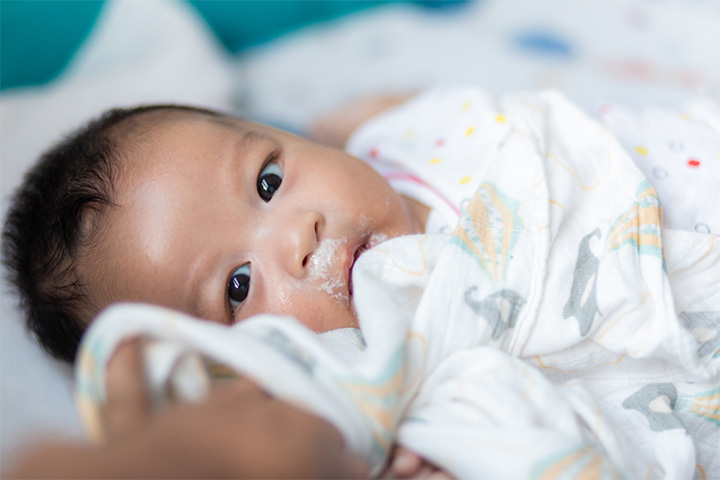Baby arching back is frequently interpreted as a symptom of discomfort or pain caused by an external or internal cause. Crying, turning the head, or sleeping are frequently associated with an arched back in babies. It could be a symptom of a minor ailment or a more serious medical condition.
This post discusses various reasons your baby is arching their back and what you can do about it.
What Is Baby Arching?
Your baby could arch backward on his lower back and throw his hands in the air. He would extend his neck back as far as he can. This is dangerous because he could slip from you arms and hurt himself.
In many cases, the baby may not arch his back until the sixth month. By nine months, he will be able to arch his back to express his discomfort, displeasure or other emotions.
Arching of the back can be a normal body language, but in some cases, it can be a symptom of some type of discomfort, indigestion delayed physical and mental development (1).
But why do babies position themselves backward? Wouldn’t that hurt them?
Why Do Babies Arch Their Backs?
From mere fatigueiXFeeling of tiredness and exhaustion. to pain, arching backs in babies can mean a lot of things. Let’s first know the harmless reasons for baby arching:
1. Expressing emotions:
Babies cannot speak, but it does not mean that they cannot communicate. Arching their back is one of the ways they express their frustration, anger, pain or such emotions. Just like adults, they could be upset for many reasons such as a change in their feeding bottle, a wet diaper or a boring toy. A sign of trapped gas after feeding also could include arching their back (2).
2. Tiredness:
Your baby can be tired after a breastfeeding session or hungry after playtime. He might find arching of his back a convenient way to communicate with you. If you want to avoid such instances, look for other less aggressive cues and act accordingly.
While these are only temporary aberrations, baby arching can also reflect something more serious or a health condition.
Dr. Leah Alexander, a New Jersey-based board-certified general pediatrician, says, “If your baby arches their back while you’re holding them, it might be a sign that they want to be put down. Some babies have stronger back muscles than others, and this is their way of telling you (besides crying) what they need.”
If the baby is younger than three months, they likely have coliciXProlonged, frequent, and intense crying or fussiness in an infant.. That’s why they arch their back, cry inconsolably for long periods, and are in pain.”
3. Arching back after feeding – Gastroesophageal reflux:
If your baby is arching back when feeding, then it could be due to gastroesophageal reflux, also called acid reflux. Acid reflux is a condition in which the contents of the stomach move upwards through the lower esophageal sphincter and enter the esophagus due to weak stomach muscles.
The lower esophageal sphincter is a bundle of muscles located at the esophagus-stomach meeting point. It works like a valve restricting the reverse flow of acid and food from the stomach into the food pipe. In babies, this valve is underdeveloped and leads to the movement of the stomach contents towards the food pipe. GERD (gastro oesophageal reflux) is quite common in infants and the baby vomits out the milk.
Your baby could arch back and vomit as a natural reaction to the reflux (3). It can also be accompanied by a cough, irritability during feeding and frequent regurgitation.
Sharing her two-month-old daughter Cora’s arching and reflex issues, Lag Liv, a mother of three, remarks, “We (me and my husband) had some concerns about her (Cora) crying and arching after eating, so she’s on Zantac for reflux now. Hopefully, that will help because right now, eating is the only time she really cries (i).”
Arching may also indicate silent reflux, wherein the baby will not vomit but still have reflux. If you notice such symptoms, consult a pediatrician. One of the common reasons for arching of the back is colic. Colic occurs secondary to gasses in the stomach, and gaseous discomfort can lead the baby to cry. Arching of the back stretches the stomach and causes relief in stomach pain. Colic starts by 4 weeks of age and goes away by 3 months of age.
The reflux has to be treated to prevent the arching of the back.
- Keep the baby upright after feeding as gravity will help pull the food down naturally and mitigate the chance of regurgitationiXA backward flow like vomiting..
- Give frequent but small feeds rather than topping his tummy in one go. This will prevent the stomach from filling to the brim.
- Do not put the baby to sleep immediately after a feed. Instead, carry the baby for some time and have a stroll. Baby arching back and crying at night are noted in babies who are fed just before going to bed.
- Do not make your baby wear tight clothing as it may put external pressure on the lower esophageal sphincter.
4. Baby arching while crying due to jaundice — Kernicterus:
If the baby arches back and cries when he is suffering from jaundice or other liver ailments, he may be showing signs of kernicterusiXA type of brain damage seen in babies., a bilirubin-induced damage to the brain. Jaundice results in excessive production of bilirubin. In extreme situations, bilirubin may breach the blood-brain barrier and damage parts of the brain, causing involuntaryiXDone without awareness or willful control. motor spasmsiXAn unusual and uncontrollable muscle contraction. (4). Kernicterus can lead to brain damage, mental retardation and seizures. This condition should be immediately notified to the doctor.
5. Baby sleeps with head arched back — Obstructive sleep apnea:
Sometimes, the baby arches back when sleeping or resting on his back. If you adjust his position, he will slip back to the arched position or violently wake-up and start crying. Such instances can indicate obstructive sleep apnea, a chronic obstruction of the upper respiratory system. The baby will try to alleviate the pressure on the upper respiratory tract by positioning his head in an arched form (5). This helps in smoother airflow in the lungs, and the baby will try to hold this position involuntarily during sleep.
Sleep apnea predominantly occurs during deep sleep but can also happen when the baby is lying down flat in a state of drowsiness.
The condition can be treated through medication or surgery.
6. Arching back while sitting — Nerve injury:
The baby arches back when sitting or when he is tired if he has a nerve injury caused by premature birth or after birth. Nerves of the baby could be damaged due to physical pressure during difficult deliveries. During a difficult delivery, nerves around the shoulder may be damaged, leading to Erb’s Palsy. Shooting pain down the shoulder and the back can cause arching of the back.
Sometimes, you may see the baby arching his back during teething due to the nerve irritation caused within the gums. Often, these baby reflexes are a result of this pain radiating to other parts of the head.
Baby arching back due to neurological disorders:
A baby arching their back could also be a symptom of neurological conditions. Following are some disorders that could be indicated by an arching back in the baby.
7. Cerebral palsy:
When the baby arches the back in this condition, he does it involuntarily and has no control on it. If the baby stretches a lot and arches back too often without any control, then it is quite likely to be an early symptom of cerebral palsy. Cerebral palsy is caused by damage to the brain generally by hypoxia during birth. Abnormal muscle tones such as Hypotonia (low muscle tone) and Hypertonia (increased muscle tone) are also significant symptoms of Cerebral Palsy. It leads to seizures and delayed mental and motor development, thus making motor milestones unachievable.
Cerebral palsy refers to a range of muscular movement disorders caused by damage to the part of the brain that controls motor movements. Look out for these back arching movements that could indicate cerebral palsy:
- Tonic labyrinthine reflex: You will see baby arching back and stiffening legs during the first few months, and this is referred to as tonic labyrinthine reflex (6).
- Asymmetrical tonic reflex: This is exhibited by the baby arching back and turning his head. The legs usually extend to the side in which the head is turned (7).
There is, unfortunately, no cure for cerebral palsy. However, you can ensure a normal upbringing for your child through numerous physical and mental therapy programs.
8. Autism:
Autism is a genetic ailment that causes stunted neurological development. Autism does not necessarily mean that the child has flawed cognitive abilities, but he could have distinct behavior. One of the early signs of autism is certain physical gestures such as arching the back when held or sleeping on the side with the head arched back (8). Since autistic individuals have trouble developing sound social relations, a baby with autism arches back when upset, to avoid physical contact with the person holding him, even if it is a parent.
However, arching the back does not mean that your baby has autism. It may just be one of the signs of autism. You need to collate several other critical symptoms of autism the baby displays in the first two years.
Baby arching back due to developmental delay:
A baby stiffening body and arching back repeatedly could be a symptom of other neurological issues that cause physical and mental developmental delays.
9. Asperger syndrome:
Asperger syndrome is characterized by difficulties in developing social bonds and having nonverbal communication through eye contact or facial gestures. It is very similar to autism in its prognosis but less severe (9).
Asperger syndrome is considered a part of autism spectrum disorder and therefore arching back could be one of the symptoms.
10. Infantile spasms:
If you observe stiffening of body and arching of back in the form of a convulsion without any other symptoms of autistic spectrum disorder, then it is quite likely the baby is going through an infantile spasm. It is called epileptic seizure and is a type of ailment in the nervous system that causes the baby to have an involuntary contraction of muscles that cause arching back and neck.
11. Rumination disorder
Apart from neurological conditions, infants may arch their backs due to eating and feeding disorders, such as rumination disorder. This happens when undigested food comes back up from the stomach into the mouth; the baby could chew, swallow, or spit it out. Babies with rumination syndrome may also strain or arch their backs and hold their head back. Additionally, you might notice your infant losing weight, experiencing frequent stomach aches, indigestion, or regurgitating food (10). If you spot these signs in your baby, consider discussing them with a doctor for a prompt diagnosis and treatment.
For serious health conditions, take your baby to the doctor immediately after you suspect that something is amiss. But if the baby is arching back for less-serious reasons, you may make an effort to discourage him.
What To Do When The Baby Is Arching Their Back?
Be it a normal or a serious condition, you may follow the below tips to help your baby. But, the first thing to do is to stop worrying.
- Calm down your baby: Take your baby into a quieter room with enough lighting. This can be soothing for babies suffering from autistic spectrum disorders.
- Cuddle your baby: Place your little one close to your chest in a comfortable, straight position so as to not put pressure on their spine. A warm cuddle with the mother can be quite comforting to the baby, calming him down. Try to relax the baby. You can lie them down and try massaging their legs and backs to relax their muscles and reduce arching.
- Divert the baby’s attention: It is an age-old trick to relieve infant discomfort and should work great for babies who arch their backs because of restlessness or irritation.
- Use comfortable clothing: Sometimes, your baby could arch due to the irritation caused by fabric or a tag in the cloth. Use comfortable fabrics for the child, in accordance with the season and temperature.
- Put the baby on a different surface: If the baby has a tendency to arch only on a certain kind of mattress or bed, then replace it with a more comfortable one.
A baby arching back is usually not a sign of ailment but an expression of irritability, fatigue, or discomfort by the baby, often triggered by pain signals, that the baby is experiencing. Try calming your baby by cuddling or diverting their attention. If you observe recurring arching of the back, it may indicate some underlying conditions such as acid reflux, jaundice, or sleep apnea. Check for accompanying symptoms that may be early manifestations of nerve problems or conditions such as autism, cerebral palsy, or infantile spasms. Consult a pediatrician if the condition seems worrisome or worsens gradually.
Key Pointers
- Baby arching back is initiated by discomfort when they push their head and back backward.
- It occurs due to indigestion, discomfort, gas, and such development.
- Changing the baby’s position or helping them burp can reduce discomfort and prevent arching.
- However, constant arching can determine serious health issues like nerve injury, sleep apnea, or so, when consulting a doctor is highly required.
If you’re wondering why your baby arches their back and cries, this video has the answers. Learn the meaning behind this behaviour and how to provide appropriate assistance and support.















